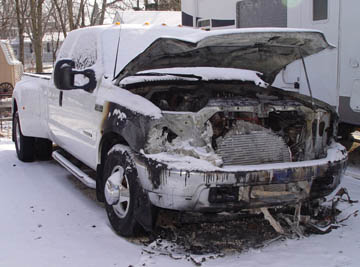
Figure 1

Figure 2
Figure 2 is a view of a vehicle equipped with a block heater that
had been connected to an AC extension cord one evening. A fire
was discovered in the vehicle the following morning. Since the
vehicle was not being driven, many of the vehicle operational fire
causes such as hot surface ignition, fuel injector malfunction and
oil leakage could be eliminated as the cause of the fire. Burn
pattern recognition is significant in Figure 2, showing severe
damage to the front of the vehicle. The aluminum air-conditioner
condensing coil is nearly consumed, while the aluminum radiator
behind it is not. Severe oxidation of the chrome front bumper and
consumption of polymer body parts, suggest an origin at the front
bumper area in the vicinity of the block heater power plug. Figure
3 is a view of the block heater power cord and plug showing
evidence of an electrical fault. Evidence of an electrical fault was
also found on a sharp corner of the bumper suggesting that
insulation breakdown from chaffing was the cause of the fire.

Figure 3

Figure 4
Figure 4 is a view of another block heater related loss. Again, burn
patterns, especially on the air-conditioning condensing coil,
suggest a block heater electrical cord related fire. Figure 5 shows
the faulted wire that was on the owner’s extension cord, which was
the likely cause of the fire.

Figure 5
As a fire analyst, one is often asked to opine on possibility of
subrogation as a result of a loss. Some issues to consider when
analyzing block heater power cord fires are as follows: Certainly
driving off while the extension cord is connected is a misuse of the
product. Subrogation potential is dependent on whether such
misuse is foreseeable. As far as the installer or manufacturer is
concerned, the routing of such a block heater power cord in the
vicinity of a sharp corner is not considered good wiring layout
design. If such a condition cannot be eliminated, sufficient
warning to the vehicle owner should be conveyed as to the
possibility that an electrical malfunction could occur.
FOR TECHNICAL ARTICLES CONTACT CLAIMS MAGAZINE AND ASK
FOR A REPRINT OF A PAST TECHNICAL NOTEBOOK ARTICLE
CLAIMS MAGAZINE
BACK TO C. ROBERTS CONSULTING ENGINEERS HOME PAGE,
WWW.CROBERTS.COM

Figure 2

Figure 3

Figure 4
Figure 4 is a view of another block heater related loss. Again, burn
patterns, especially on the air-conditioning condensing coil,
suggest a block heater electrical cord related fire. Figure 5 shows
the faulted wire that was on the owner’s extension cord, which was
the likely cause of the fire.

Figure 5
As a fire analyst, one is often asked to opine on possibility of
subrogation as a result of a loss. Some issues to consider when
analyzing block heater power cord fires are as follows: Certainly
driving off while the extension cord is connected is a misuse of the
product. Subrogation potential is dependent on whether such
misuse is foreseeable. As far as the installer or manufacturer is
concerned, the routing of such a block heater power cord in the
vicinity of a sharp corner is not considered good wiring layout
design. If such a condition cannot be eliminated, sufficient
warning to the vehicle owner should be conveyed as to the
possibility that an electrical malfunction could occur.
FOR TECHNICAL ARTICLES CONTACT CLAIMS MAGAZINE AND ASK
FOR A REPRINT OF A PAST TECHNICAL NOTEBOOK ARTICLE
CLAIMS MAGAZINE
BACK TO C. ROBERTS CONSULTING ENGINEERS HOME PAGE,
WWW.CROBERTS.COM

Figure 4

Figure 5
As a fire analyst, one is often asked to opine on possibility of
subrogation as a result of a loss. Some issues to consider when
analyzing block heater power cord fires are as follows: Certainly
driving off while the extension cord is connected is a misuse of the
product. Subrogation potential is dependent on whether such
misuse is foreseeable. As far as the installer or manufacturer is
concerned, the routing of such a block heater power cord in the
vicinity of a sharp corner is not considered good wiring layout
design. If such a condition cannot be eliminated, sufficient
warning to the vehicle owner should be conveyed as to the
possibility that an electrical malfunction could occur.
FOR TECHNICAL ARTICLES CONTACT CLAIMS MAGAZINE AND ASK
FOR A REPRINT OF A PAST TECHNICAL NOTEBOOK ARTICLE
CLAIMS MAGAZINE
BACK TO C. ROBERTS CONSULTING ENGINEERS HOME PAGE,
WWW.CROBERTS.COM
FOR TECHNICAL ARTICLES CONTACT CLAIMS MAGAZINE AND ASK
FOR A REPRINT OF A PAST TECHNICAL NOTEBOOK ARTICLE
CLAIMS MAGAZINEWWW.CROBERTS.COM